WORLD'S TOP RICE PRODUCING COUNTRIES
.jpg)
Rice grains The two main strains or rice sold in the world market are the “japonica” and “indica” subspecies. Paddy rice describes rice grown in a field with water (a paddy). A tonne (or metric ton) is a metric unit of mass equivalent to 1,000 kilograms (kgs) or 2,204.6 pounds (lbs). A ton is an imperial unit of mass equivalent to 1,016.047 kg or 2,240 lbs.
World’s Top Producers of Rice, Paddy (2020): 1) China: 211860000 tonnes; 2) India: 178305000 tonnes; 3) Bangladesh: 54905891 tonnes; 4) Indonesia: 54649202 tonnes; 5) Vietnam: 42758897 tonnes; 6) Thailand: 30231025 tonnes; 7) Myanmar: 25100000 tonnes; 8) Philippines: 19294856 tonnes; 9) Brazil: 11091011 tonnes; 10) Cambodia: 10960000 tonnes; 11) United States: 10322990 tonnes; 12) Japan: 9706250 tonnes; 13) Pakistan: 8419276 tonnes; 14) Nigeria: 8172000 tonnes; 15) Nepal: 5550878 tonnes; 16) Sri Lanka: 5120924 tonnes; 17) Egypt: 4893507 tonnes; 18) South Korea: 4713162 tonnes; 19) Tanzania: 4528000 tonnes; 20) Madagascar: 4232000 tonnes. [Source: FAOSTAT, Food and Agriculture Organization (U.N.), fao.org]
World’s Top Producers (in terms of value) of Rice, Paddy (2019): 1) China: Int.$81973652,000; 2) India: Int.$69471549,000; 3) Indonesia: Int.$21353974,000; 4) Bangladesh: Int.$21347057,000; 5) Vietnam: Int.$16991387,000; 6) Thailand: Int.$11089508,000; 7) Myanmar: Int.$10273324,000; 8) Philippines: Int.$7357906,000; 9) Pakistan: Int.$4346905,000; 10) Cambodia: Int.$4257183,000; 11) Japan: Int.$4116789,000; 12) Brazil: Int.$4054848,000; 13) Nigeria: Int.$3298672,000; 14) United States: Int.$3275880,000; 15) Egypt: Int.$2616255,000; 16) Nepal: Int.$2193904,000; 17) South Korea: Int.$1961637,000; 18) Sri Lanka: Int.$1795813,000; 19) Madagascar: Int.$1654672,000; [An international dollar (Int.$) buys a comparable amount of goods in the cited country that a U.S. dollar would buy in the United States.]
Top rice-producing countries in 2008: (first Production in $1000; second production, metric tons in 2008, FAO): 1) China, 36561286 , 193354175; 2) India, 30246312 , 148260000; 3) Indonesia, 12440012 , 60251072; 4) Bangladesh, 9868753 , 46905000; 5) Viet Nam, 7918880 , 38725100; 6) Thailand, 6059404 , 31650632; 7) Myanmar, 5612813 , 30500000; 8) Philippines, 3382928 , 16815548; 9) Brazil, 2522762 , 12061465; 10) Japan, 2337305 , 11028750; 11) Pakistan, 2162313 , 10428000; 12) United States of America, 1930780 , 9241173; 13) Egypt, 1476323 , 7253373; 14) Republic of Korea, 1464007 , 6919250; 15) Cambodia, 1463123 , 7175473; 16) Nigeria, 864799 , 4179000; 17) Nepal, 850799 , 4299264; 18) Sri Lanka, 802185 , 3875000; 19) Madagascar, 592679 , 3000000; 20) Peru, 584882 , 2775800;
See Separate Article RICE: PLANT, FOOD, CROP, HISTORY, AND AGRICULTURE factsanddetails.com
Rice Processing
Threshing separates the grain from the rest of the plant. Sometimes it is done mechanically and sometimes people or animals trample the sheaves. After threshing the rice is ready for milling. If the rice is not completely dry it is often spread out on communal yards or highways to dry in the sun. Rice dryers are widely used in some regions now. Milling removes the husk from the kernel. Sometimes the process also strips off the bran layer which contains most of the nutrients. Brown rice still has its bran coat. Milling 10 kilograms of rice with a machine takes about 5 minutes. By hand it takes it two to three hours.[Source: Vietnam-culture.com vietnam-culture.com
Typically After rice is harvested it is usually taken to a local rice processing plant where huge two-story machines with conveyor belts and vibrators removes the husks and other impurities, polish the rice and deposit in a bag ready to eat. The best machines come from Japan. Nothing is wasted in rice processing. Rice can be turned into everything from paper to pudding. It’s steamed, puffed and flaked. It can be used to make noodles, wine, cosmetics and cooking oil. While the kernels are eaten, the stalks are made into straw and used for making sandals, hats, baskets, ropes, brooms and thatched roofs. The hulls provide fuel and fertilizer. The husks and other left over materials are fed to pigs or other animals.
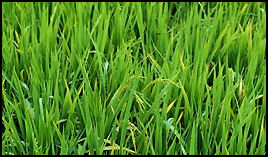
Rice plants Describing the "modern way" of husking rice used in some parts of Asia, Patrick Tyler wrote in the New York Times, "First a tractor was driven, in reverse, in fast and furious circles over the dried rice stalks. The process resembled a dangerous rodeo stunt as the tractor bounded over 5- and 6-foot piles of rice stalks, narrowly missing farm hands, women and children who pushed and pulled at the straw to insure that all of it got run over several times." [Source: Patrick Tyler, New York Times, November 2, 1995]
"The crazy dance of the tractor caused most of the rice grains still inside the husks to separate from the stalks," Tyler wrote. "The peasants then bundled and beat the stalks against the side of a wooden box, collecting as many grains as they could. The stalks were then built into stacks, which would be burned to fertilize the fields...The rice grains were left on the concrete slab mixed with the debris of the stalks. After a few more hours of raking and hurling the debris into the air, the rice was finally separated from the chaff and the harvest was bagged for storage."
Much of the rice produced in Thailand is put in 100 pound bags that are stacked in walls 27 bags high in warehouses along the Chao Phray River in Bangkok. The rice commodities market like most agricultural businesses is highly speculative and a gamble, which the Thai's love. One dealer sold $305 million dollars of rice to Iran, but waited until the last minute to buy the rice from his suppliers. In that time the price of the rice dropped $25 a ton and he walked away with a quick profit of three quarters of a million dollars. [Source: Peter White, National Geographic, May 1994]
Improved Rice Yields
Rice plants have been greatly improved over the last three decades. Plant breeders have created plants that mature in 110 days instead 160 which means that regions with warm climates can grow three crops instead of two. The height of the average plant has been reduced from five feet to a stocky three feet, which means that the plant nutrient go into producing grains of rice and are not "wasted" on the stalks that lean over when there is too much weight. In addition, rice plants have been bred and bio-engineered to be resistant to bacterial blight, plant hoppers and stem borders.
Tall conventional rice plant used before 1968 grew in 140-180 days and yielded between 0.6 and 1.4 tons per acre. Modern rice grows in 110-140 days, produces 100 seeds per panicle, and yields between 2.4 and 4.0 tons per acre.
The introduction of new more productive strains of rice (and corn and wheat) to developing countries like India and Indonesia in the 1960s was called the "Green Revolution." Before the Green revolution India had problems feeding itself, now it exports rice. Between 1967 and 1992 the world's rice harvest has doubled. in Indonesia it tripled from 15 million tons to 48 million tons.
By the year 2020 it is believed the world's rice crop will increase by an additional 60 percent. Current dwarf varieties have 15 productive panicles, or seed clusters per stalk (out 25 or so total stalks) that produce about 100 grains (seeds) each. New strains will have fewer, but stronger and thicker, stalks that will yield 200 or more grains each. These new plants are expected to account for most of the increased productivity.
World's Top Rice Exporting Countries
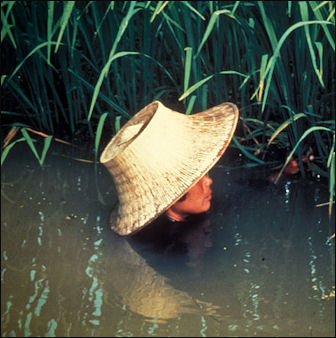
new deep water varieties of rice World’s Top Exporters of Rice, Paddy (2020): 1) United States: 1373402 tonnes; 2) Brazil: 518496 tonnes; 3) India: 414412 tonnes; 4) Paraguay: 249255 tonnes; 5) Uruguay: 162847 tonnes; 6) Guyana: 93870 tonnes; 7) Cambodia: 75307 tonnes; 8) Greece: 63662 tonnes; 9) Russia: 61903 tonnes; 10) Bulgaria: 38741 tonnes; 11) Spain: 33324 tonnes; 12) Suriname: 29859 tonnes; 13) China: 22960 tonnes; 14) Italy: 19932 tonnes; 15) Tanzania: 19725 tonnes; 16) Pakistan: 13600 tonnes; 17) France: 5704 tonnes; 18) Portugal: 5449 tonnes; 19) South Africa: 3971 tonnes; 20) Romania: 3580 tonnes
[Source: FAOSTAT, Food and Agriculture Organization (U.N.), fao.org]
World’s Top Exporters (in value terms) of Rice, Paddy (2020): 1) United States: US$466718,000; 2) Brazil: US$139600,000; 3) India: US$136318,000; 4) China: US$82845,000; 5) Cambodia: US$77547,000; 6) Paraguay: US$60712,000; 7) Uruguay: US$50733,000; 8) Guyana: US$27875,000; 9) Greece: US$25983,000; 10) Russia: US$22428,000; 11) Suriname: US$17635,000; 12) Bulgaria: US$16772,000; 13) Italy: US$14320,000; 14) Spain: US$13635,000; 15) Tanzania: US$5660,000; 16) Romania: US$3042,000; 17) South Africa: US$2460,000; 18) France: US$2455,000; 19) Netherlands: US$2306,000; 20) Portugal: US$2276,000
The worlds top exporters of rice in 1991 were: 1) Thailand, 2) the United States, 3) Pakistan, 4) Vietnam, 5) China, 6) Australia, 7) Italy, 8) India, 9) Uruguay, 10) Spain.
World's Top Rice Importing Countries
World’s Top Importers of Rice, Paddy (2020): 1) Mexico: 788623 tonnes; 2) Nepal: 395234 tonnes; 3) Venezuela: 312381 tonnes; 4) Brazil: 244804 tonnes; 5) Costa Rica: 184509 tonnes; 6) Turkey: 179494 tonnes; 7) Colombia: 177863 tonnes; 8) Guatemala: 147293 tonnes; 9) Honduras: 141332 tonnes; 10) Panama: 131721 tonnes; 11) Nicaragua: 113305 tonnes; 12) Vietnam: 88944 tonnes; 13) El Salvador: 85841 tonnes; 14) Libya: 70000 tonnes; 15) Portugal: 50766 tonnes; 16) Yemen: 50000 tonnes; 17) China: 27311 tonnes; 18) Italy: 20062 tonnes; 19) Philippines: 18712 tonnes; 20) Spain: 16567 tonnes
[Source: FAOSTAT, Food and Agriculture Organization (U.N.), fao.org]
World’s Top Importers (in value terms) of Rice, Paddy (2020): 1) Mexico: US$274758,000; 2) Nepal: US$110146,000; 3) Venezuela: US$104223,000; 4) Vietnam: US$102633,000; 5) Colombia: US$88815,000; 6) Brazil: US$82070,000; 7) Turkey: US$78893,000; 8) Philippines: US$75260,000; 9) Costa Rica: US$63113,000; 10) Guatemala: US$52042,000; 11) Honduras: US$51963,000; 12) Panama: US$51659,000; 13) Nicaragua: US$47248,000; 14) Pakistan: US$33286,000; 15) El Salvador: US$30512,000; 16) Yemen: US$30000,000; 17) Libya: US$24500,000; 18) Portugal: US$21875,000; 19) Bangladesh: US$14367,000; 20) Italy: US$13725,000
The worlds top importers of rice in 1991 were: 1) Iran, 2) the USSR, 3) Saudi Arabia, 4) Senegal, 5) Hong Kong, 6) Malaysia, 7) South Africa, 8) Brazil, 9) Turkey and 10) Ivory Coast.
World's Top Milled Rice Equivalent Producing and Exporting Countries
For exports and imports, paddy rice and brown rice are converted into the weight they would be as milled rice (white rice, see Milled Rice below).

Cambodia World’s Top Producers of Rice, Paddy (Rice Milled Equivalent) (2020): 1) China: 141310620 tonnes; 2) India: 118929435 tonnes; 3) Bangladesh: 36622229 tonnes; 4) Indonesia: 36451018 tonnes; 5) Vietnam: 28520184 tonnes; 6) Thailand: 20164094 tonnes; 7) Myanmar: 16741700 tonnes; 8) Philippines: 12869669 tonnes; 9) Brazil: 7397704 tonnes; 10) Cambodia: 7310320 tonnes; 11) United States: 6885434 tonnes; 12) Japan: 6474069 tonnes; 13) Pakistan: 5615657 tonnes; 14) Nigeria: 5450724 tonnes; 15) Nepal: 3702436 tonnes; 16) Sri Lanka: 3415656 tonnes; 17) Egypt: 3263969 tonnes; 18) South Korea: 3143679 tonnes; 19) Tanzania: 3020176 tonnes; 20) Madagascar: 2822744 tonnes [Source: FAOSTAT, Food and Agriculture Organization (U.N.), fao.org]
World’s Top Exporters of Rice, Paddy (Rice Milled Equivalent) (2020): 1) India: 14462834 tonnes; 2) Vietnam: 5685849 tonnes; 3) Thailand: 5665164 tonnes; 4) Pakistan: 3944136 tonnes; 5) United States: 2791901 tonnes; 6) China: 2270515 tonnes; 7) Myanmar: 1845199 tonnes; 8) Brazil: 1217888 tonnes; 9) Uruguay: 962023 tonnes; 10) Paraguay: 795233 tonnes; 11) Italy: 749340 tonnes; 12) Cambodia: 630941 tonnes; 13) Guyana: 579364 tonnes; 14) Belgium: 409546 tonnes; 15) Tanzania: 342598 tonnes; 16) Argentina: 329295 tonnes; 17) Spain: 284033 tonnes; 18) Netherlands: 256455 tonnes; 19) Turkey: 233962 tonnes; 20) Taiwan: 224197 tonnes
World’s Top Exporters (in value terms) of Rice, Paddy (Rice Milled Equivalent) (2020): 1) India: US$7980028,000; 2) Thailand: US$3710031,000; 3) Vietnam: US$2790951,000; 4) Pakistan: US$2101268,000; 5) United States: US$1888782,000; 6) China: US$916644,000; 7) Myanmar: US$773176,000; 8) Italy: US$712946,000; 9) Brazil: US$503577,000; 10) Cambodia: US$479186,000; 11) Uruguay: US$461557,000; 12) Belgium: US$359881,000; 13) Netherlands: US$326198,000; 14) Paraguay: US$295008,000; 15) Guyana: US$259090,000; 16) Spain: US$223239,000; 17) Argentina: US$154090,000; 18) Tanzania: US$141992,000; 19) Turkey: US$121400,000; 20) Taiwan: US$114400,000
World's Top Milled Rice Exporting Countries
Milled rice refers to rice kernels that have been milled to remove the bran, leaving "white" or milled rice. Whole milled rice — with broken kernels removed — is the type of rice typically sold in stores for normal cooking.
World’s Top Exporters of Milled Rice (2020): 1) India: 12993122 tonnes; 2) Thailand: 4946597 tonnes; 3) Vietnam: 4801883 tonnes; 4) Pakistan: 2821106 tonnes; 5) China: 2021534 tonnes; 6) United States: 1601622 tonnes; 7) Uruguay: 664725 tonnes; 8) Italy: 631296 tonnes; 9) Cambodia: 502373 tonnes; 10) Brazil: 486550 tonnes; 11) Paraguay: 373158 tonnes; 12) Guyana: 329149 tonnes; 13) Tanzania: 299688 tonnes; 14) Argentina: 249767 tonnes; 15) Turkey: 221877 tonnes; 16) Taiwan: 215699 tonnes; 17) Netherlands: 150094 tonnes; 18) Spain: 149125 tonnes; 19) Singapore: 100068 tonnes; 20) Laos: 88049 tonnes
[Source: FAOSTAT, Food and Agriculture Organization (U.N.), fao.org]
World’s Top Exporters (in value terms) of Milled Rice (2020): 1) India: US$7484136,000; 2) Thailand: US$3292167,000; 3) Vietnam: US$2360612,000; 4) Pakistan: US$1532879,000; 5) United States: US$1198472,000; 6) China: US$664161,000; 7) Italy: US$613672,000; 8) Cambodia: US$349145,000; 9) Uruguay: US$332012,000
10 ) Brazil: US$237169,000; 11) Netherlands: US$221606,000; 12) Guyana: US$159934,000; 13) Paraguay: US$151412,000; 14) Spain: US$137145,000; 15) Tanzania: US$128100,000; 16) Argentina: US$119719,000; 17) Turkey: US$116632,000; 18) Taiwan: US$108958,000; 19) United Kingdom: US$73039,000; 20) Laos: US$53736,000

threshing rice in 19th century Japan
World’s Top Exporters of Milled Rice/Husked (2020); 1) Belgium: 182110 tonnes; 2) Myanmar: 108791 tonnes; 3) Germany: 65398 tonnes; 4) Japan: 35398 tonnes; 5) Cambodia: 22255 tonnes; 6) Laos: 3540 tonnes; 7) Iran: 279 tonnes; 8) Romania: 99 tonnes; 9) Suriname: 75 tonnes; 10) Bangladesh: 63 tonnes; 11) Iraq: 19 tonnes; 12) Cote d’Ivoire: 1 tonne; 13) Ghana: 1 tonne; 14) Cameroon: 1 tonne
World’s Top Exporters (in value terms) of Milled Rice/Husked (2020): 1) Belgium: US$245432,000; 2) Germany: US$71915,000; 3) Myanmar: US$61518,000; 4) Japan: US$48470,000; 5) Cambodia: US$18677,000; 6) Laos: US$6279,000; 7) Iran: US$418,000; 8) Romania: US$107,000; 9) Bangladesh: US$62,000; 10) Suriname: US$37,000; 11) Iraq: US$22,000; 12) Côte d'Ivoire: US$1,000; 13) Cameroon: US$1,000; 14) Bhutan: US$1,000
Exports classified as medium- and short-grain and account for about one-third of annual U.S. rice exports. The remaining U.S. rice exports are nearly all classified as long-grain, and have the cooking, visual, and eating characteristics of indica rice. The United States is currently the fifth-largest rice exporting country and accounts for 8-9 percent of global trade. Although a major exporter, the United States accounts for about 1.5 percent of global rice production, with exports typically accounting for nearly half of total U.S. production.[Source: Economic Research Service/USDA United States Department of Agriculture, September 2016]
The global japonica market is small, currently accounting for around 7 percent of global exports and exhibiting only slight growth. Expansion of the global japonica market is expected to be small over the next decade, with indica continuing to account for most of the annual growth. Furthermore, there is little, if any, substitution globally by importers between indica and japonica rice. In addition to the United States, Egypt, Australia, China, Russia, and the European Union regularly export japonica rice. Japan also exports japonica rice, all as food aid. None of the major Southeast and South Asian rice exporters ship japonica rice. The import market is concentrated as well. Northeast Asia (Japan, South Korea, and Taiwan) is the largest market, buying around half of total global japonica shipments.
The United States competes with both Australia and China for japonica sales to Northeast Asia. The Middle East and North Africa is the next-largest market, with Libya and Turkey the top buyers in the region. The United States competes primarily with Egypt and Russia in this regional market. Russia also exports japonica rice to markets in Central Asia. Oceania is also a market for japonica rice, with Australia typically supplying most of these imports.
Japan is consistently the largest buyer of U.S. japonica rice, taking almost 330,000 tons a year, with milled rice accounting for the bulk of purchases. Turkey typically ranks second, purchasing mostly medium-grain rough rice from the United States. Korea is typically the third-largest buyer of U.S. japonica rice, taking both milled and brown rice. Taiwan, Jordan, and Libya are the next-largest buyers of U.S. japonica rice. Although mostly a long-grain importer, Canada regularly takes smaller amounts of U.S. japonica rice. Asian buyers of U.S. japonica rice typically prefer the varieties grown in California instead of the medium-grain varieties produced in the South, despite consistently lower prices for Southern rice. However, importers in the Middle East often purchase Southern mediumgrain varieties, especially when the price difference is wide.
Egypt has a large population to feed and has periodically restricted exports in recent years to diminish domestic food price inflation. Egypt placed restrictions on rice exports in April 2016. The European Union is a high-cost grower unlikely to expand production to increase exports.
China is currently the world’s largest rice importer — nearly all indica — and is facing record or near-record total domestic use, quality concerns regarding domestic rice, and a long-term substitution to japonica from indica rice in the domestic market. China had seen prices rise because of internal demand and supply dynamics and its rising minimum support prices (Gale, 2013). It is evident that japonica rice is a premium grain product in China. [Source: Economic Research Service/USDA United States Department of Agriculture, September 2016]
World's Top Brown Rice Exporting Countries
Husked (brown) rice refers to rice in which only the husk has been removed. Brown rice is unpolished rice that has not been milled to remove the hull from the kernel. It retains the rice bran layer and the germ, which gives it a nutty flavor and chewy texture.
World’s Top Exporters of Husked Rice (2020): 1) Myanmar: 1060399 tonnes; 2) Pakistan: 381460 tonnes; 3) United States: 265544 tonnes; 4) China: 259374 tonnes; 5) Paraguay: 202847 tonnes; 6) Thailand: 148442 tonnes; 7) Guyana: 130670 tonnes; 8) Uruguay: 117218 tonnes; 9) Spain: 97080 tonnes; 10) Vietnam: 96691 tonnes; 11) Netherlands: 70891 tonnes; 12) Italy: 69440 tonnes; 13) Argentina: 66884 tonnes; 14) Bulgaria: 46848 tonnes; 15) Belgium: 33723 tonnes; 16) Cambodia: 29648 tonnes; 17) Suriname: 29462 tonnes; 18) India: 27117 tonnes; 19) Greece: 11950 tonnes; 20) Brazil: 11434 tonnes
[Source: FAOSTAT, Food and Agriculture Organization (U.N.), fao.org]
World’s Top Exporters (in value terms) of Husked Rice (2020): 1) Myanmar: US$442655,000; 2) Pakistan: US$307203,000; 3) United States: US$191820,000; 4) China: US$168867,000; 5) Thailand: US$105618,000; 6) Netherlands: US$83751,000; 7) Italy: US$67149,000; 8) Paraguay: US$62568,000; 9) Spain: US$61466,000; 10) Guyana: US$53339,000; 11) Uruguay: US$50872,000; 12) Vietnam: US$44194,000; 13) Belgium: US$36192,000; 14) Argentina: US$28788,000; 15) Bulgaria: US$20343,000; 16) Suriname: US$17635,000; 17) Cambodia: US$17006,000; 18) India: US$10903,000; 19) Japan: US$10448,000; 20) Germany: US$9118,000
World's Top Broken Rice Exporting and Importing Countries
Broken rice is fragments of rice grains, broken in the field, during drying, during transport, or during milling.
World’s Top Exporters of Broken Rice (2020): 1) India: 1175939 tonnes; 2) Vietnam: 795942 tonnes; 3) Myanmar: 781894 tonnes; 4) Pakistan: 770876 tonnes; 5) Thailand: 584969 tonnes; 6) Brazil: 384025 tonnes; 7) Belgium: 196043 tonnes; 8) Uruguay: 85951 tonnes; 9) Paraguay: 77497 tonnes; 10) Guyana: 71596 tonnes; 11) United States: 58578 tonnes; 12) Senegal: 48375 tonnes; 13) Kazakhstan: 47442 tonnes; 14) Italy: 42592 tonnes; 15) Netherlands: 40811 tonnes; 16) South Africa: 33287 tonnes; 17) Cambodia: 30680 tonnes; 18) Tanzania: 26148 tonnes; 19) Spain: 25875 tonnes; 20) Argentina: 19332 tonnes
[Source: FAOSTAT, Food and Agriculture Organization (U.N.), fao.org]
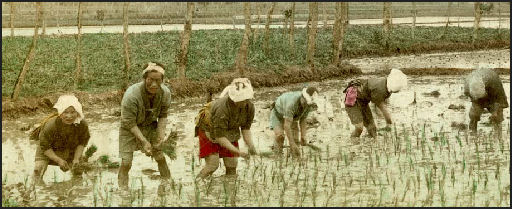
planting rice in 19th century Japan
World’s Top Exporters (in value terms) of Broken Rice (2020): 1) Vietnam: US$384059,000; 2) India: US$348671,000; 3) Thailand: US$312245,000; 4) Myanmar: US$268929,000; 5) Pakistan: US$259132,000; 6) Brazil: US$121229,000; 7) Belgium: US$77544,000; 8) United States: US$31772,000; 9) Uruguay: US$27940,000; 10) Paraguay: US$20316,000; 11) Senegal: US$19212,000; 12) South Africa: US$18587,000; 13) Netherlands: US$18535,000; 14) Guyana: US$17942,000; 15) Italy: US$17805,000; 16) Cambodia: US$16811,000; 17) Kazakhstan: US$11696,000; 18) Spain: US$10993,000; 19) Uganda: US$7422,000; 20) Portugal: US$6993,000
World’s Top Importers of Broken Rice (2020): 1) Senegal: 1104780 tonnes; 2) China: 995110 tonnes; 3) Ghana: 640000 tonnes; 4) Cuba: 446705 tonnes; 5) Indonesia: 322343 tonnes; 6) Burkina Faso: 321054 tonnes; 7) Côte d'Ivoire: 312218 tonnes; 8) Ethiopia: 309364 tonnes; 9) Belgium: 298825 tonnes; 10) Gambia: 266381 tonnes; 11) Togo: 219621 tonnes; 12) Sierra Leone: 177698 tonnes; 13) Zimbabwe: 162245 tonnes; 14) Djibouti: 128263 tonnes; 15) France: 117761 tonnes; 16) United Kingdom: 109668 tonnes; 17) Afghanistan: 103962 tonnes; 18) Guinea-Bissau: 89587 tonnes; 19) Netherlands: 74014 tonnes; 20) Switzerland: 64250 tonnes
World’s Top Importers (in value terms) of Broken Rice (2020): 1) China: US$424397,000; 2) Senegal: US$416769,000; 3) Cuba: US$231004,000; 4) Ghana: US$210000,000; 5) Indonesia: US$175547,000; 6) Côte d'Ivoire: US$135261,000; 7) Belgium: US$127644,000; 8) Zimbabwe: US$96263,000; 9) Burkina Faso: US$77591,000; 10) Philippines: US$71764,000; 11) Sierra Leone: US$63449,000; 12) Ethiopia: US$56267,000; 13) France: US$55517,000; 14) United Kingdom: US$48603,000; 15) Gambia: US$44316,000; 16 ) Djibouti: US$43075,000; 17) Togo: US$42282,000; 18) Afghanistan: US$37679,000; 19) Guinea-Bissau: US$35931,000; 20) Netherlands: US$28948,000
Rice Research
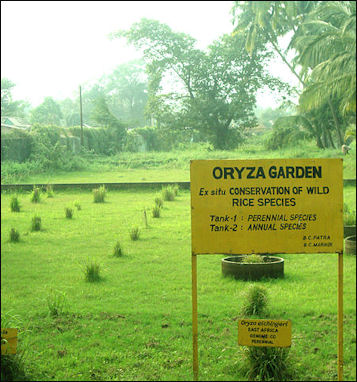
Central Rice Research Institute
in Bidyadharpur, India Most new strains of rice have been developed at the International Rice Research Institute (IRRI) in Los Banos, the Philippines. Founded in 1967, the IRRI has produced 300 different varsities of rice. One strain, called IR36, is resistant to 15 insect, disease and environmental stresses and is currently planted on about 27 million acres worldwide.
The IRRI Genetics Research Center houses samples from over 80,000 varieties of rice, which are cross bred to produce new strains. Strains with desirable characteristics are saved and breed again. Usually, it takes at least six generations for these characteristics to actually become a reproducible trait of the plant.
The Bill and Melinda Gates Foundation gave the HarvestPlus project $25 million to develop rice, wheat, beans and cassava with increased amounts of iron and zinc, micronutrients often lacking in the diet of people in the developing world. Iron deficiency is blamed for 100,000 maternal deaths in childbirth every year. Zinc deficiency give people less immunity to infectious diseases. The program relies more on traditional breeding methods rather than on genetic engineering.
New varieties that are resistant to disease and pests, and have high yields and short growing times still have one final test to pass — the taste test. Many promising strains have gotten this far only to fail. At the Chinese National Rice Research Institute near Hangzhou in the Zhejiang Province taste testers sample over 150 varieties of rice from 15 provinces in three days. The rice is graded by a dozen evaluators and judged in terms of smell, appearance and taste on a one to five scale. Lumpy, yellowish varieties that stick to the roof of the mouth usually receives poor marks while springy, gleaming white rice that goes down smooth receives high marks.
Biotechnology and Rice
Genetic engineering is enabling scientist to transfer desirable qualities from one plant to another by transplanting the genes of cells in a plant with a desired trait to the cell in a different plant. These methods help researchers to isolate the characteristic they are after and speed up the breeding process. Using these methods the Japanese have developed a strain with a gene that kills insects but does not harm people.
The mapping out of the entire genetic code (genome) for rice was announced by an international team of scientists in 2005. The achievement is expected to result in improvements that will help billions of people. Rice, wheat and corn and other cereal crops such as barely, rye, sorghum and millet are all similar genetically and thus beneficial properties of one may be passed on to the another.
Rice contains 37,544 genes, compared to only 25,000 found in human beings. The mapping project was carried about by scientists from 32 institutions in 10 countries and expanded on work initially done by the companies Syngenta and Monsanto. Genes linked to processes such as flowering have already been discovered. Genetic similarities between rice and barely is helping scientists protect barely from two major diseases: barely powdery mildew and stem rust.
In the Yunnan Province of China, researchers are experimenting with genetically-modifying rice with wild strains of rice that thrive in cool temperatures, high altitudes and dry soils and contain significant amounts of calcium, vitamins and iron. Zeng Yawmen, a scientist working outside Kunming told AP, “We can extract the cold-tolerant gene from this plant and use it in a genetically-manipulated variety to increase its cold tolerance.”
Super Rice and Golden Rice

rice in the lab
In 1995, scientists at the IRRI announced that they had developed a "super rice" that grows in 100-130 days, yields up to 5.3 tons per acre, and produces 200 to 250 seeds per panicle, compared to 100 in most modern rice varieties. The goal of the super rice program was to produce a plant that devotes its energy to produce grain in panicles rather leaves and stems.
When it is available the new rice is expected to increase yields in irrigated fields by 25 percent (from 10 tons per hectare to 12 tons per hectare) with less fertilizer than modern varieties. It is hoped that the "super rice" will hope to keep up with demands made by a growing population and offset the loss of agricultural to industry.
Super rice will not be introduced until it has been crossbreed to produce disease-resistant strain that can grown in a variety of climates and conditions. In the late 1990s, super rice strains were given to rice breeders in different parts of the world to be crossbred with varieties suited to local soils, temperatures and rainfall and could deal with a pests and diseases it is expected to encounter.
Golden rice is a kind of rice that has been genetically engineered to contain beta-carotene, a substance gives carrots their orange color and helps the human body can convert to Vitamin A Golden rice has been modified with a daffodil gene to produce beta-carotene, which the normally white grains a pale yellow color.
Golden rice has been marketed as a way to reduce blindness caused by Vitamin A deficiency among children in the Third World, where an estimated 500,000 people go blind from Vitamin A deficiency every year. A closer look at golden rice however shows that it is not all that it is cranked up to. A child would have to to eat 15 pounds of golden rice a day to get the daily minimum requirement of Vitamin A and the $150 million spent to develop and market it to people who like their rice white could have been put to much better use on something else. Some people argue the rice was pushed to help the biotech companies that produce it not Third World children.
Nerica
Nerica is a “miracle rice” developed for Africa by combining hardy African strains with productive Asian strains. Created in 1994 at the West Africa Rice Development Association (WARDA), also known as the Africa Rice Center, it produces 50 percent larger crops that are rich in protein; doesn’t require much fertilizer or pesticides; grows well in acidic soils; resists disease, pests, weeds, and drought; and matures in 30 to 50 days. Nerica stands for “new rice for Africa.” It has been touted as a solution for Africa’s food problems.
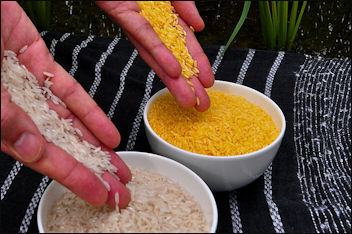
Golden rice Nerica was developed by merging two different species, which usually creates hybrids that, like mules made form a horse and a donkey, can not produce fertilized offspring or reproduce. This problem was overcome by using parts of the seeds taken from both the Asian and African rices and fertilizing them with Asian-African hybrids cross fertilized two times with Asian rice. About 3,000 varieties of Nerica were developed, of which 18 proved to be good at producing large yields in dry weather.
Nerica was is developed from Glaberrima, a strain used in Africa for 3,500 years. It ears are smaller than Asian varieties and prone to collapse. Bred with Asian sativa varieties that have large ears that produce more grain. The short growing time is one reason is can survive through droughts.
A Ugandan farmer who grows Nerica told the Yomiuri Shimbun, “Nerica grows more easily than I first thought, and my children like it. I can harvest two times a years, and it can be sold for higher prices than other crops. And so I recommend it to my neighbors.”
Image Source: Wikimedia Commons; Ray Kinnane, Jun from Goods in Japan, MIT, University of Washington, Nolls China website
Text Sources: National Geographic, New York Times, Washington Post, Los Angeles Times, Smithsonian magazine, Natural History magazine, Discover magazine, Times of London, The New Yorker, Time, Newsweek, Reuters, AP, AFP, Lonely Planet Guides, Compton’s Encyclopedia and various books and other publications.
Last updated March 2022
